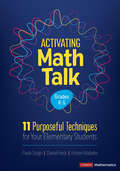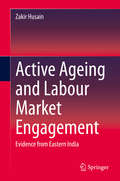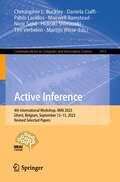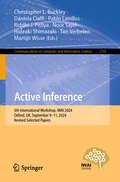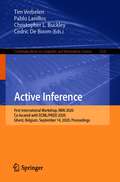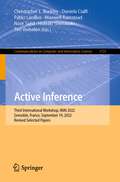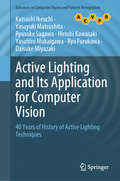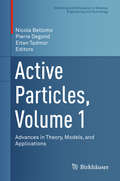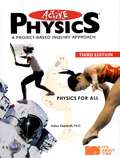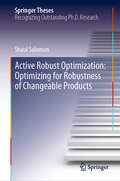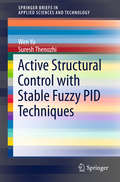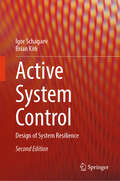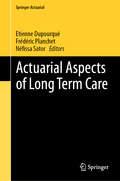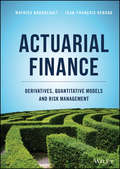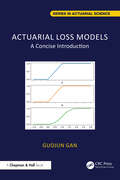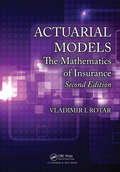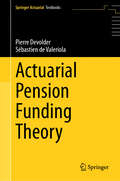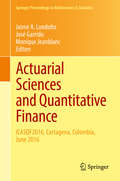- Table View
- List View
Activating Math Talk: 11 Purposeful Techniques for Your Elementary Students (Corwin Mathematics Series)
by Paola Sztajn Daniel Heck Kristen MalzahnAchieve High-Quality Mathematics Discourse With Purposeful Talk Techniques Many mathematics teachers agree that engaging students in high quality discourse is important for their conceptual learning, but successfully promoting such discourse in elementary classrooms—with attention to the needs of every learner—can be a challenge. Activating Math Talk tackles this challenge by bringing practical, math-specific, productive discourse techniques that are applicable to any lesson or curriculum. Framed around 11 student-centered discourse techniques, this research-based book connects purposeful instructional techniques to specific lesson goals and includes a focus on supporting emergent multilingual learners. You will be guided through each technique with Classroom examples of tasks and techniques spanning grades K–5 Reflection moments to help you consider how key ideas relate to your own instruction Classroom vignettes that illustrate the techniques in action and provide opportunities to analyze and prepare for your own implementation Group discussion questions for engaging with colleagues in your professional community Achieving high-quality mathematics discourse is within your reach using the clear-cut techniques that activates your math talk efforts to promote every student’s conceptual learning.
Activating Math Talk: 11 Purposeful Techniques for Your Elementary Students (Corwin Mathematics Series)
by Paola Sztajn Daniel Heck Kristen MalzahnAchieve High-Quality Mathematics Discourse With Purposeful Talk Techniques Many mathematics teachers agree that engaging students in high quality discourse is important for their conceptual learning, but successfully promoting such discourse in elementary classrooms—with attention to the needs of every learner—can be a challenge. Activating Math Talk tackles this challenge by bringing practical, math-specific, productive discourse techniques that are applicable to any lesson or curriculum. Framed around 11 student-centered discourse techniques, this research-based book connects purposeful instructional techniques to specific lesson goals and includes a focus on supporting emergent multilingual learners. You will be guided through each technique with Classroom examples of tasks and techniques spanning grades K–5 Reflection moments to help you consider how key ideas relate to your own instruction Classroom vignettes that illustrate the techniques in action and provide opportunities to analyze and prepare for your own implementation Group discussion questions for engaging with colleagues in your professional community Achieving high-quality mathematics discourse is within your reach using the clear-cut techniques that activates your math talk efforts to promote every student’s conceptual learning.
Active Ageing and Labour Market Engagement: Evidence from Eastern India
by Zakir HusainThe book provides an interesting analysis of the time-use data to examine the extent to which active ageing is occurring in India. It also synthesizes data from the National Sample Survey Office All India Survey and another survey undertaken in Kolkata, Bhubaneswar, and Ranchi (capital cities of East Indian states) to examine the role of the aged in the Indian Society. Nearly all countries in the world are experiencing an important issue of ageing. India faces its own set of challenges with its aging population due to the absence of a social security system—the shifting family dynamics questions the contribution of the elderly to the family in every aspect. Econometric models have been used in the book to study gender differences and variations across socio-economic conditions, correlating them to the contribution of the aged to their families and the extent of active ageing. The book broadens the understanding on the aged and facilitates their integration in the society so that they can age more actively. Active Ageing and Labour Market Engagement offers an analytical perspective to professionals, researchers, and policy makers interested in gerontology.
Active Assisted Living: Anwendungsszenarien und Lösungsansätze für ein selbstbestimmtes Leben
by Marcel Sailer Andreas MahrIn dem vorliegenden Open-Access-Buch identifizieren Studierende und Lehrende interprofessionell Entwicklungen und Problemfelder der Assistiven Technologien. Diese halten zunehmend Einzug ins Leben versorgungsbedürftiger, häufig älterer Menschen. Nach einigen Jahren der Entwicklung kann konstatiert werden, dass der Transfer von Entwicklung zur Anwendung im Alltag infolge unterschiedlicher Perspektiven und Zielsetzungen nur unzureichend stattfindet. Die Beitragsautoren bieten kreative Lösungsansätze, die zu einer nachhaltigen Umsetzung führen sollen.Dies ist ein Open-Access-Buch.
Active Inference: 4th International Workshop, IWAI 2023, Ghent, Belgium, September 13–15, 2023, Revised Selected Papers (Communications in Computer and Information Science #1915)
by Tim Verbelen Pablo Lanillos Christopher L. Buckley Daniela Cialfi Maxwell Ramstead Noor Sajid Hideaki Shimazaki Martijn WisseThis volume constitutes the papers of the 4th International Workshop on Active Inference, IWAI 2023, held in Ghent, Belgium on September 2023.The 17 full papers included in this book were carefully reviewed and selected from 34 submissions. They were organized in topical sections as follows: active inference and robotics; decision-making and control; active inference and psychology; from theory to implementation; learning representations for active inference; and theory of learning and inference.
Active Inference: 5th International Workshop, IWAI 2024, Oxford, UK, September 9–11, 2024, Revised Selected Papers (Communications in Computer and Information Science #2193)
by Tim Verbelen Pablo Lanillos Christopher L. Buckley Daniela Cialfi Noor Sajid Hideaki Shimazaki Martijn Wisse Riddhi J. PitliyaThis book constitutes the revised selected papers of the 5th International Workshop on Active Inference, IWAI 2024, held in Oxford, UK, during September 9–11, 2024. The 17 full papers included in this book were carefully reviewed and selected from 54 submissions. They were organized in topical sections as follows: Modeling Behaviour and Emotions; Hybrid Continuous-discrete Systems; Structure Learning; Multi-agent Systems; Epistemic Sampling; Robot Control; and Sustainability and Contextuality.
Active Inference: First International Workshop, IWAI 2020, Co-located with ECML/PKDD 2020, Ghent, Belgium, September 14, 2020, Proceedings (Communications in Computer and Information Science #1326)
by Tim Verbelen Pablo Lanillos Christopher L. Buckley Cedric De BoomThis book constitutes the refereed proceedings of the First International Workshop on Active Inference, IWAI 2020, co-located with ECML/PKDD 2020, held in Ghent, Belgium, in September 2020. The 13 full papers along with 6 short papers were thoroughly reviewed and selected from 25 submissions. They are organized in the topical sections on active inference and continuous control; active inference and machine learning; active inference: theory and biology.
Active Inference: Third International Workshop, IWAI 2022, Grenoble, France, September 19, 2022, Revised Selected Papers (Communications in Computer and Information Science #1721)
by Tim Verbelen Pablo Lanillos Christopher L. Buckley Daniela Cialfi Maxwell Ramstead Noor Sajid Hideaki ShimazakiThis volume constitutes the papers of the 3rd International Workshop on Active Inference, IWAI 2022, held in Grenoble, France, in conjunction with ECML/PKDD, on September 19, 2022.The 25 revised full papers presented in this book were carefully reviewed and selected from 31 submissions.
Active Lighting and Its Application for Computer Vision: 40 Years of History of Active Lighting Techniques (Advances in Computer Vision and Pattern Recognition)
by Katsushi Ikeuchi Yasuyuki Matsushita Ryusuke Sagawa Hiroshi Kawasaki Yasuhiro Mukaigawa Ryo Furukawa Daisuke MiyazakiThis book describes active illumination techniques in computer vision. We can classify computer vision techniques into two classes: passive and active techniques. Passive techniques observe the scene statically and analyse it as is. Active techniques give the scene some actions and try to facilitate the analysis. In particular, active illumination techniques project specific light, for which the characteristics are known beforehand, to a target scene to enable stable and accurate analysis of the scene. Traditional passive techniques have a fundamental limitation. The external world surrounding us is three-dimensional; the image projected on a retina or an imaging device is two-dimensional. That is, reduction of one dimension has occurred. Active illumination techniques compensate for the dimensional reduction by actively controlling the illumination. The demand for reliable vision sensors is rapidly increasing in many application areas, such as robotics and medical image analysis. This book explains this new endeavour to explore the augmentation of reduced dimensions in computer vision. This book consists of three parts: basic concepts, techniques, and applications. The first part explains the basic concepts for understanding active illumination techniques. In particular, the basic concepts of optics are explained so that researchers and engineers outside the field can understand the later chapters. The second part explains currently available active illumination techniques, covering many techniques developed by the authors. The final part shows how such active illumination techniques can be applied to various domains, describing the issue to be overcome by active illumination techniques and the advantages of using these techniques. This book is primarily aimed at 4th year undergraduate and 1st year graduate students, and will also help engineers from fields beyond computer vision to use active illumination techniques. Additionally, the book is suitable as course material for technical seminars.
Active Particles, Volume 1: Advances in Theory, Models, and Applications (Modeling and Simulation in Science, Engineering and Technology)
by Nicola Bellomo Pierre Degond Eitan TadmorThis volume collects ten surveys on the modeling, simulation, and applications of active particles using methods ranging from mathematical kinetic theory to nonequilibrium statistical mechanics. The contributing authors are leading experts working in this challenging field, and each of their chapters provides a review of the most recent results in their areas and looks ahead to future research directions. The approaches to studying active matter are presented here from many different perspectives, such as individual-based models, evolutionary games, Brownian motion, and continuum theories, as well as various combinations of these. Applications covered include biological network formation and network theory; opinion formation and social systems; control theory of sparse systems; theory and applications of mean field games; population learning; dynamics of flocking systems; vehicular traffic flow; and stochastic particles and mean field approximation. Mathematicians and other members of the scientific community interested in active matter and its many applications will find this volume to be a timely, authoritative, and valuable resource.
Active Particles, Volume 2: Advances in Theory, Models, and Applications (Modeling and Simulation in Science, Engineering and Technology)
by Nicola Bellomo Pierre Degond Eitan TadmorThis volume compiles eight recent surveys that present state-of-the-art results in the field of active matter at different scales, modeled by agent-based, kinetic, and hydrodynamic descriptions. Following the previously published volume, these chapters were written by leading experts in the field and accurately reflect the diversity of subject matter in theory and applications. Several mathematical tools are employed throughout the volume, including analysis of nonlinear PDEs, network theory, mean field approximations, control theory, and flocking analysis. The book also covers a wide range of applications, including:Biological network formationSocial systemsControl theory of sparse systemsDynamics of swarming and flocking systemsStochastic particles and mean field approximationsMathematicians and other members of the scientific community interested in active matter and its many applications will find this volume to be a timely, authoritative, and valuable resource.
Active Particles, Volume 3: Advances in Theory, Models, and Applications (Modeling and Simulation in Science, Engineering and Technology)
by Nicola Bellomo Eitan Tadmor José Antonio CarrilloThis edited volume collects six surveys that present state-of-the-art results on modeling, qualitative analysis, and simulation of active matter, focusing on specific applications in the natural sciences. Following the previously published Active Particles volumes, these chapters are written by leading experts in the field and reflect the diversity of subject matter in theory and applications within an interdisciplinary framework. Topics covered include:Variability and heterogeneity in natural swarmsMultiscale aspects of the dynamics of human crowdsMathematical modeling of cell collective motion triggered by self-generated gradientsClustering dynamics on graphsRandom Batch Methods for classical and quantum interacting particle systemsThe consensus-based global optimization algorithm and its recent variantsMathematicians and other members of the scientific community interested in active matter and its many applications will find this volume to be a timely, authoritative, and valuable resource.
Active Particles, Volume 4: Theory, Models, Applications (Modeling and Simulation in Science, Engineering and Technology)
by Eitan Tadmor José Antonio CarrilloThis edited volume collects nine surveys that present the state-of-the-art in modeling, qualitative analysis, and simulation of active particles, focusing on specific applications in the natural sciences. As in the preceding Active Particles volumes, it blends diverse applications that demonstrate the interdisciplinary nature of the subject and the various mathematical tools available. Contributions were selected with the aim of covering a variety of viewpoints, from modeling the interactions in collective dynamics of animals and in population dynamics; through neural-networks, semi-supervised learning, and Monte Carlo methods in optimization; to kinetic and continuum theories with applications to aggregations and birth-and-death processes. Mathematicians and other members of the scientific community interested in active matter and its many applications will find this volume to be a timely, authoritative, and valuable resource.
Active Physics - A Project Based Inquiry Approach
by Arthur EisenkraftActive Physics is based on research in the cognitive sciences- the research on how students learn-encapsulated in the 7E Instructional Model (Elicit, Engage, Explore, Explain, Elaborate, Evaluate, Extend). As a result, Active Physics provides ALL students with a deep and memorable learning experience. Cover topics like Driving the Roads, Electricity, Music and Sound, Sports and Thrills and Chills.
Active Robust Optimization: Optimizing for Robustness of Changeable Products (Springer Theses)
by Shaul SalomonThis book presents a novel framework, known as Active Robust Optimization, which provides the tools for evaluating, comparing and optimizing changeable products. Since any product that can change its configuration during normal operation may be considered a “changeable product,” the framework is widely applicable. Further, the methodology enables designers to use adaptability to deal with uncertainties and so avoid over-conservative designs. Offering a comprehensive overview of the framework, including its unique features, such as its ability to optimally respond to uncertain situations, the book also defines a new class of optimization problem and examines the effects of changes in various parameters on their solution. Lastly, it discusses innovative approaches for solving the problem and demonstrates these with two examples from different fields in engineering design: optimization of an optical table and optimization of a gearbox.
Active Structural Control with Stable Fuzzy PID Techniques (SpringerBriefs in Applied Sciences and Technology)
by Wen Yu Suresh ThenozhiThis book presents a detailed discussion of intelligenttechniques to measure the displacement of buildings when they are subjected tovibration. It shows how these techniques are used to control active devicesthat can reduce vibration 60-80% more effectively than widely used passiveanti-seismic systems. After introducing various structural control devices andbuilding-modeling and active structural control methods, the authors proposeoffset cancellation and high-pass filtering techniques to solve some commonproblems of building-displacement measurement using accelerometers. The mostpopular control algorithms in industrial settings, PD/PID controllers, are thenanalyzed and then combined with fuzzy compensation. The stability of thiscombination is proven with standard weight-training algorithms. These conditionsprovide explicit methods for selecting PD/PID controllers. Finally, fuzzy-logicand sliding-mode control are applied to the control of wind-induced vibration. The methods described are supported by reports of experimental studies on atwo-story building prototype. This book is avaluable resource for academic researchers interested in the effects of controland mechatronic devices within buildings, or those studying the principles ofvibration reduction. Practicing engineers working on the design andconstruction of any sort of high-rise or vulnerable building and concerned withthe effects of either wind or seismic disturbances benefit from the efficacy ofthe methods proposed.
Active System Control: Design of System Resilience
by Brian Kirk Igor SchagaevNow in its second edition, this book introduces an approach to active system control. This approach, when applied through design and development improves our technological systems. It extends concepts of system control using data accumulation, state and structural dependencies. The authors define these properties in terms of reliability, performance and energy-efficiency, and self-adaption. They describe how they bridge the gap between data accumulation and analysis in terms of interpolation with the real physical models when data used for interpretation of the system conditions. The authors introduce a principle of active system control and safety - an approach that explains what a model of a system should have, making computer systems more efficient, a crucial new concern in application domains such as safety critical, embedded and low-power autonomous systems like transport, healthcare, and other dynamic systems with moving substances and elements. On a theoretical level, this book further extends the concept of fault tolerance, introducing a system level of design for improving overall efficiency. On a practical level it illustrates how active system approach might help our systems become self-evolving. This updated new edition of Active System Control contains new chapters on the system software concept and the future of active systems control and a chapter containing case studies of unsolved aviation safety incidents.
Acts of God and Man: Ruminations on Risk and Insurance (Columbia Business School Publishing Ser.)
by Michael PowersMuch has been written about the ups and downs of financial markets, from the lure of prosperity to the despair of crises. Yet a more fundamental and pernicious source of uncertainty exists in today's world: the traditional "insurance" risks of earthquakes, storms, terrorist attacks, and other disasters. Insightfully exploring these "acts of God and man," Michael R. Powers guides readers through the methods available for identifying and measuring such risks, financing their consequences, and forecasting their future behavior within the limits of science.A distinctive characteristic of earthquakes, hurricanes, bombings, and other insurance risks is that they impact the values of stocks, bonds, commodities, and other market-based financial products, while remaining largely unaffected by or "aloof" from the behavior of markets. Quantifying such risks given limited data is difficult yet crucial for achieving the financing objectives of insurance. Powers begins with a discussion of how risk impacts our lives, health, and possessions and proceeds to introduce the statistical techniques necessary for analyzing these uncertainties. He then considers the experience of risk from the perspectives of both policyholders and insurance companies, and compares their respective responses.The risks inherent in the private insurance industry lead naturally to a discussion of the government's role as both market regulator and potential "insurer of last resort." Following a thoughtful and balanced analysis of these issues, Powers concludes with an interdisciplinary investigation into the nature of uncertainty, incorporating ideas from physics, philosophy, and game theory to assess science's limitations in predicting the ramifications of risk.
Actuarial Aspects of Long Term Care (Springer Actuarial)
by Frédéric Planchet Etienne Dupourqué Néfissa SatorThis book proposes a review of Long-Term Care insurance; this issue is addressed both from a global point of view (through a presentation of the risk of dependence associated with the aging of the population) and an actuarial point of view (with the presentation of existing insurance products and actuarial techniques for pricing and reserving). It proposes a cross-view of American and European experiences for this risk. This book is the first dedicated entirely to long-term care insurance and aims to provide a useful reference for all actuaries facing this issue. It is intended for both professionals and academics.
Actuarial Finance: Derivatives, Quantitative Models and Risk Management
by Mathieu Boudreault Jean-François RenaudA new textbook offering a comprehensive introduction to models and techniques for the emerging field of actuarial Finance Drs. Boudreault and Renaud answer the need for a clear, application-oriented guide to the growing field of actuarial finance with this volume, which focuses on the mathematical models and techniques used in actuarial finance for the pricing and hedging of actuarial liabilities exposed to financial markets and other contingencies. With roots in modern financial mathematics, actuarial finance presents unique challenges due to the long-term nature of insurance liabilities, the presence of mortality or other contingencies and the structure and regulations of the insurance and pension markets. Motivated, designed and written for and by actuaries, this book puts actuarial applications at the forefront in addition to balancing mathematics and finance at an adequate level to actuarial undergraduates. While the classical theory of financial mathematics is discussed, the authors provide a thorough grounding in such crucial topics as recognizing embedded options in actuarial liabilities, adequately quantifying and pricing liabilities, and using derivatives and other assets to manage actuarial and financial risks. Actuarial applications are emphasized and illustrated with about 300 examples and 200 exercises. The book also comprises end-of-chapter point-form summaries to help the reader review the most important concepts. Additional topics and features include: Compares pricing in insurance and financial markets Discusses event-triggered derivatives such as weather, catastrophe and longevity derivatives and how they can be used for risk management; Introduces equity-linked insurance and annuities (EIAs, VAs), relates them to common derivatives and how to manage mortality for these products Introduces pricing and replication in incomplete markets and analyze the impact of market incompleteness on insurance and risk management; Presents immunization techniques alongside Greeks-based hedging; Covers in detail how to delta-gamma/rho/vega hedge a liability and how to rebalance periodically a hedging portfolio. This text will prove itself a firm foundation for undergraduate courses in financial mathematics or economics, actuarial mathematics or derivative markets. It is also highly applicable to current and future actuaries preparing for the exams or actuary professionals looking for a valuable addition to their reference shelf. As of 2019, the book covers significant parts of the Society of Actuaries’ Exams FM, IFM and QFI Core, and the Casualty Actuarial Society’s Exams 2 and 3F. It is assumed the reader has basic skills in calculus (differentiation and integration of functions), probability (at the level of the Society of Actuaries’ Exam P), interest theory (time value of money) and, ideally, a basic understanding of elementary stochastic processes such as random walks.
Actuarial Loss Models: A Concise Introduction (Chapman & Hall/CRC Series in Actuarial Science)
by Guojun GanActuarial loss models are statistical models used by insurance companies to estimate the frequency and severity of future losses, set premiums, and reserve funds to cover potential claims. Actuarial loss models are a subject in actuarial mathematics that focus on the pricing and reserving for short-term coverages.This is a concise textbook written for undergraduate students majoring in actuarial science who wish to learn the basics of actuarial loss models. This book can be used as a textbook for a one-semester course on actuarial loss models. The prerequisite for this book is a first course on calculus. The reader is supposed to be familiar with differentiation and integration.This book covers part of the learning outcomes of the Fundamentals of Actuarial Mathematics (FAM) exam and the Advanced Short-Term Actuarial Mathematics (ASTAM) exam administered by the Society of Actuaries. It can be used by actuarial students and practitioners who prepare for the aforementioned actuarial exams.Key Features: Review core concepts in probability theory. Cover important topics in actuarial loss models. Include worked examples. Provide both theoretical and numerical exercises. Include solutions of selected exercises.
Actuarial Models for Disability Insurance
by S Haberman E PitaccoDisability insurance, long-term care insurance, and critical illness cover are becoming increasingly important in developed countries as the problems of demographic aging come to the fore. The private sector insurance industry is providing solutions to problems resulting from these pressures and other demands of better educated and more prosperous
Actuarial Models: The Mathematics of Insurance, Second Edition
by Vladimir I. RotarActuarial Models: The Mathematics of Insurance, Second Edition thoroughly covers the basic models of insurance processes. It also presents the mathematical frameworks and methods used in actuarial modeling. This second edition provides an even smoother, more robust account of the main ideas and models, preparing students to take exams of the Societ
Actuarial Pension Funding Theory (Springer Actuarial)
by Pierre Devolder Sébastien de ValeriolaThis book offers a broad and up-to-date account of the actuarial principles of pensions. Divided into three parts, it includes discussions on both social security schemes and private pension funds, and aspects of life insurance. The first part presents the general principles of pension schemes. After a general look at the pension issue and some basic elements of demography, the main methods of financing a pension plan, for example pay-as-you-go or funding, are described in a unified way. The second part gives a detailed analysis of the pay-as-you-go methodologies for social security schemes. Recent concepts such as notional defined contribution plans, hybrid schemes and point systems are studied from an actuarial perspective. The final part, devoted to funding techniques, examines the main individual and collective funding methods, such as unit credit and aggregate cost, and looks at the management of actuarial gains and losses. This is the first book to give a joint and up-to-date analysis of public and private pension schemes from an actuarial point of view. Aimed primarily at undergraduate and graduate students, and actuaries involved in pensions, it will also be useful to mathematicians, economist, accountants, and anyone with basic quantitative training who is interested in pension issues.
Actuarial Sciences and Quantitative Finance: ICASQF2016, Cartagena, Colombia, June 2016 (Springer Proceedings in Mathematics & Statistics #214)
by Jaime A. Londoño José Garrido Monique JeanblancDeveloped from the Second International Congress on Actuarial Science and Quantitative Finance, this volume showcases the latest progress in all theoretical and empirical aspects of actuarial science and quantitative finance. Held at the Universidad de Cartagena in Cartegena, Colombia in June 2016, the conference emphasized relations between industry and academia and provided a platform for practitioners to discuss problems arising from the financial and insurance industries in the Andean and Caribbean regions. Based on invited lectures as well as carefully selected papers, these proceedings address topics such as statistical techniques in finance and actuarial science, portfolio management, risk theory, derivative valuation and economics of insurance.
